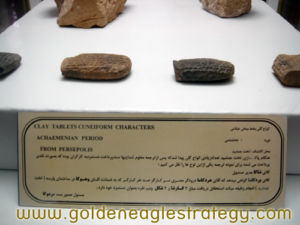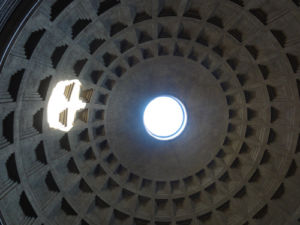It has always been interesting for me to learn more about the business process and lifestyle in ancient times and know how our ancestors managed their lives and their economy at the time. I have recently had the privilege to travel more within Europe for some of my business consultancy projects and did not miss any single opportunity to visit museums and ancient historical monuments. Among these monuments two of them attracted my attention deeper as they prove the existence of some business and management terms that we are using today.

One of my most fascinating visits was in Iran when I visited the Parseh Building ruins (Persepolis) in April 2007. Persepolis or Parseh is the ruins of the Achaemenid empire capital (550-330 B.C.). There are some innovations in Persepolis, but what made me keep it in mind business-wise were the clay tablets that were used as accounting documents. The clay tablets have been written in for of cuneiform character and the translation done by archaeologists revealed many facts of the trade at the time of more than 2500 years ago. The archaeologists found couple of these clay tablets in their excavations that after translation they found out these are the wage receipts for workers of Persepolis. Here is the translation of one of these clay tablets:
Mr. Shaka, the Cash Manager
Mr. Bardkama certifies that Mr. Hardkama, the Egyptian supervisor of 100 workers who worked under the endorsement of Mr. Vahooka in Parseh Building (Persepolis) deserves to receive 3 Karsha and 3 Shekl and half silver as his wage.
The Issuer of document,
Mardooka
This document translation reveals popular business terms that we use today were existed and used since more than 2500 years ago. The work of Egyptians in Persepolis is the internationalization and outsourcing that we have today. Many companies outsource due to the cost reduction and some do due to the know-how. Moreover, there were management, organization, supervisors, and accounting documents were kept in a form of clay tablets. Sometimes we just consider that these terms are new and we use them in our own era.
The second monument I have found interesting was about the innovation I have seen in Pantheon Dome in Rome, Italy. The history goes back in 37 B.C. and building was built as a temple. Before entering the building everything looks natural as such amazing buildings is not that special in Rome. After entering the building I faced an amazing sundial made by a hole in the ceiling that lets the sunlight through and the light lies in a particular place of the building that make it possible to specify the time of the day. This amazing structure of about 2000 years ago works well as a clock. During summer and winter there is difference between the places where the light lies, however, the time can be defined from the sun light at any time.

Such innovation of letting the sun through and managing the time from the sun light in about 2000 years ago is not just a normal happening. This is the evident that the human beings used to innovate, manage the time, and time was important part of their lives too. It was not only their need to have night and day or dark and light, but also they managed to specifically define the time in an innovative way.
The ancient history is interesting both life-wise and business-wise. Our ancestors used to innovate and have management. They paid salaries and kept the receipts. They had supervisors and cash managers and they had organizations and hierarchies. They outsourced their work, not only due to their costs saving, but they used talented people. They had international trade and they worked in foreign countries. Isn’t it the same way as we do today? Maybe just in another ways, but the concepts are the same.
